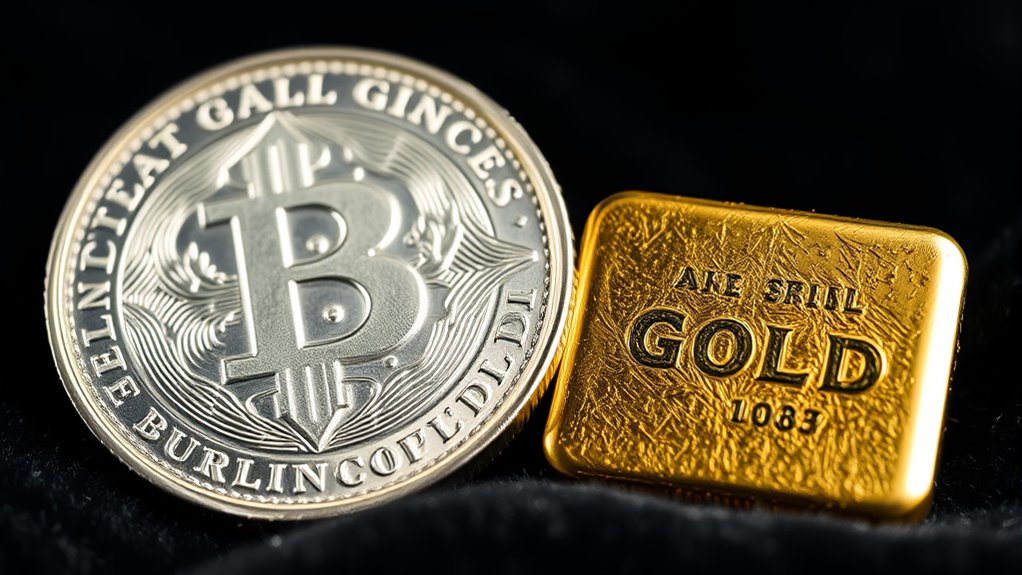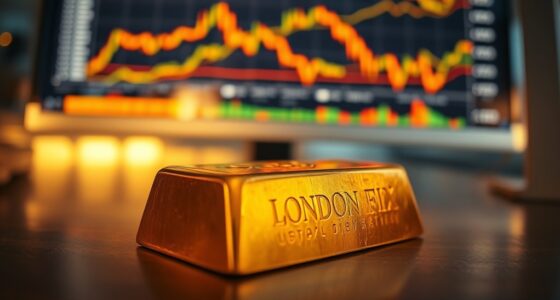The gold-silver ratio shows how many ounces of silver equal one ounce of gold, helping you gauge if metals are undervalued or overvalued. It reflects market trends, economic conditions, and supply-demand shifts. Historically, the ratio fluctuates based on inflation, crises, and technological changes. By monitoring this ratio, you can spot buying or selling opportunities and refine your investment strategy. If you keep exploring, you’ll discover how to interpret and use this powerful tool like a pro.

Understanding the gold-silver ratio is essential for investors looking to gauge the relative value of these two precious metals. This ratio is calculated by dividing the current price of gold by the price of silver, providing a straightforward way to see how many ounces of silver are needed to buy one ounce of gold. It’s a useful metric because it reflects market sentiment, supply and demand dynamics, and historical trends. When the ratio is high, silver tends to be undervalued compared to gold, and when it’s low, gold may be relatively cheaper. This simple calculation can reveal opportunities and help you make smarter investment decisions.
The gold-silver ratio shows how many ounces of silver are needed to buy one ounce of gold.
Historically, the gold-silver ratio has experienced wide fluctuations. During the Roman Empire, it was around 12:1, meaning you needed 12 ounces of silver for one ounce of gold. Fast forward to recent times, during the COVID-19 pandemic in April 2020, the ratio skyrocketed to about 125:1, showing how market turmoil can cause dramatic shifts. At the end of the 19th century, the ratio was fixed at 15:1, aligning with the monetary standards of the time. Even centuries ago, during Alexander the Great’s era, the ratio hovered around 12.5, illustrating that the relationship between these metals has long been influenced by supply, demand, and economic conditions.
Economic factors play a significant role in moving the ratio. Changes in supply and demand, inflation, and recessionary pressures can all impact the prices of gold and silver differently. Central bank policies, political instability, and technological advances also influence market dynamics, shifting the ratio accordingly. For instance, during times of economic uncertainty, investors often flock to gold as a safe haven, which can cause the ratio to fall or rise depending on how silver prices respond. The ratio can also be affected by changes in mining output and technological innovations that alter the supply of metals. Additionally, technological innovations can influence the market supply of metals, which in turn affects the ratio.
You can leverage the gold-silver ratio in your trading strategies by identifying when metals are undervalued or overvalued. When the ratio gets unusually high, silver may be undervalued, offering a buying opportunity. Conversely, a low ratio could signal that gold is undervalued. Many traders use futures, ETFs, options, or pooled accounts to capitalize on expected shifts in the ratio, aiming to profit regardless of overall price trends. Monitoring the ratio regularly helps you anticipate market changes and refine your investment approach.
Currently, the ratio hovers around 90:1, meaning it takes about 90 ounces of silver to buy one ounce of gold. This reflects ongoing market conditions and investor sentiment, providing real-time insight into relative valuations. To stay ahead, you should regularly calculate the ratio by dividing current gold prices by silver prices, using live data. Keeping an eye on this ratio over time allows you to spot trends, identify potential entry points, and develop a more informed, strategic approach to investing in these metals.
Frequently Asked Questions
How Does the Gold-Silver Ratio Influence Investment Decisions?
You see how the gold-silver ratio guides your investment choices by indicating relative value shifts between metals. When the ratio widens, you might buy silver, expecting it to catch up as it’s undervalued. Conversely, a narrowing ratio suggests gold’s stronger appeal, prompting you to contemplate gold. Monitoring these movements helps you decide when to diversify or hedge, balancing risk and opportunity based on market signals.
What Historical Events Have Impacted the Gold-Silver Ratio?
You’re curious about how history has shaped the gold-silver ratio. Major moments like Menes’s early Egyptian edicts, Roman reforms, and Renaissance silver discoveries drastically shifted metal values. Colonial conquests flooded markets with silver, causing swings. Modern monetary policies, from the gold standard to the abandonment of gold backing, sparked significant shifts. These events created a dynamic dance, driving fluctuations and defining the ratio’s historic highs and lows.
Can the Ratio Predict Future Precious Metal Prices?
You wonder if the ratio can predict future precious metal prices. It often signals when silver is undervalued, especially when the ratio hits high levels like 80 to 100, suggesting silver could rally. Keep in mind, the ratio’s mean-reverting nature means extreme values usually lead to corrections. By monitoring these fluctuations, you can spot potential buying opportunities, but remember, timing the market remains unpredictable.
How Do Industrial Uses of Silver Affect Its Ratio With Gold?
Imagine silver as a bustling factory floor, where every new gadget, solar panel, or electric car demands its shiny metal. This industrial use means silver’s ratio with gold shifts based on demand, not just market sentiment. When industry booms, silver’s value rises faster, lowering the gold-silver ratio. Conversely, if industrial demand wanes, the ratio widens. So, industrial uses directly influence this ratio, reflecting silver’s role in our tech-driven world.
Is the Gold-Silver Ratio Relevant for Short-Term Traders?
Yes, the gold-silver ratio is relevant for short-term traders. You can use it to identify entry and exit points by spotting extremes and deviations from historical norms. Volatility in silver prices makes the ratio a useful tool for quick trades. By applying technical analysis and managing risk carefully, you can capitalize on short-term fluctuations, taking advantage of mean reversion and market sentiment shifts to generate profits.
Conclusion
Now that you understand the gold-silver ratio, you’re basically a financial wizard with a crystal ball! This ratio isn’t just numbers; it’s your secret weapon to spotting precious metal opportunities before they explode. Keep an eye on those ratios, and you’ll navigate the market like a pro surfer catching the biggest wave of wealth. Remember, mastering this ratio can turn your investment game into a legendary success story—so go ahead, make those smart moves!









